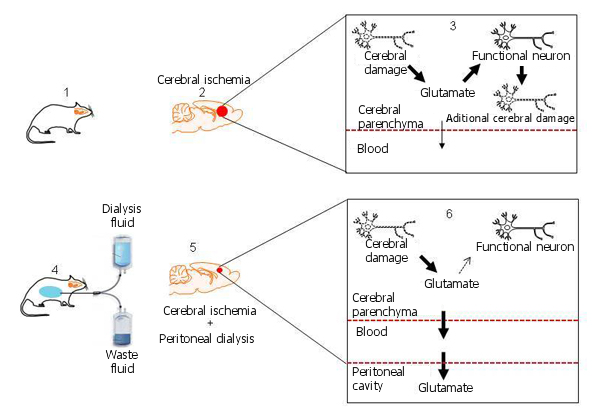NOVEL TREATMENT FOR STROKE
|
Description |
Researchers from Universidad Complutense, in collaboration with Hospital Universitario La Princesa in Madrid and Instituto de Neurociencias in Alicante, have developed a fast and easy method to alleviate brain damage caused by cerebrovascular diseases, in particular, stroke.
This novel treatment is focused in decreasing blood glutamate levels using peritoneal dialysis, a technique that may be used in both ischaemic and haemorrhagic stroke patients.
The composition of the peritoneal dialysis solution as well as its use for the treatment of cerebrovascular diseases are protected by national and supranational patents.

The occlusion of the rat middle cerebral artery that recapitulates a stroke causes (1) an ischaemic lesion (2) that kills and/or energetically and metabolically damages neurons (3). Due to this cellular damage, neurons release large amount of glutamate that are toxic to healthy neurons surrounding the lesion, amplifying the damage. The same occlusion in rats undergoing peritoneal dialysis (4) induces a lesser ischaemic lesion (5) as the glutamate outflow towards blood is increased (5) due to its dialysis-induced removal in blood.
|
How does it work |
Neurovascular diseases, specifically stroke, are the 2nd-3rd cause of death in developed countries, being 2nd in men and 1st in women in Spain. They are considered the first cause of neurological disability and 2nd of dementia. Affecting 50% of the population over 60 years of age, cerebrovascular diseases are a medical emergency that pose a major societal health problem.
Despite the high incidence of stroke, there is only one pharmacological treatment available for ischaemic, not for haemorrhagic stroke, the thrombolytic therapy using tissue plasminogen activator (t-PA, alteplase), able to recanalise the occluded blood vessel; however, its use is restricted, in average, to 3-5% of the patients.
Glutamate accumulation in the extracellular space of the brain parenchyma plays a pivotal role in the evolution of stroke-induced neuronal damage. Glutamate is an excitatory neurotransmitter used by neurons in their intercellular communication; however, in large amounts, it is neurotoxic. Therefore, an active field of research is focused on sequestering or removing blood glutamate.
The novel therapeutic model now proposed consists of using peritoneal dialysis with specifically formulated dialysis solutions. The treatment is based on the existence of a balance between extracellular fluid and blood, in such a way that a reduction in blood glutamate levels will drain glutamate from those brain areas in which this neurotransmitter accumulates after stroke.
|
Advantages |
This is a simple method, that can be applied in patients shortly after hospital admission, and which is useful for both ischaemic and haemorrhagic stroke. The short time required for dialysis catheter implantation ensures that the administration of the treatment is well within the effective therapeutic window for glutamate clearance.
The simplicity and the effectiveness of this therapeutic strategy suggests its early translation to clinics. In this context, a phase II clinical trial is ongoing in Hospital de La Princesa aimed to demonstrate the safety of the method.
|
Where has it been developed |
The team that has developed this method is integrated by professors of the Medical and Veterinary Schools of Universidad Complutense de Madrid, in collaboration with Hospital Universitario de la Princesa de Madrid and Instituto de Neurociencias de Alicante.
The Complutense teams are part of the Neurovascular Research Unit, which develops stroke preclinical studies using advanced technologies and methodological approaches (surgery rooms; molecular biology, histology and microscopy labs; etc.). They work in tight collaboration with the stroke unit of the Neurology Department of Hospital La Princesa de Madrid, where they implement translational studies and clinical trials.
|
And also |
The composition of the dialysis solution is protected by a national patent and a PCT application.
UCM is interested in contacting companies that may be interested in the development of this therapeutic method and/or in the acquisition of an exploitation licence of the patent.
|
Contact |
|
© Office for the Transfer of Research Results – UCM |
|
PDF Downloads |
|
Classification |
|
Responsible Researcher |
Ignacio Lizasoaín: ignacio.lizasoain@med.ucm.es
Department: Farmacology
Faculty: Medicine
José Sánchez-Prieto: jsprieto@vet.ucm.es
Department: Biochemistry
Faculty: Veterinary Medicine


